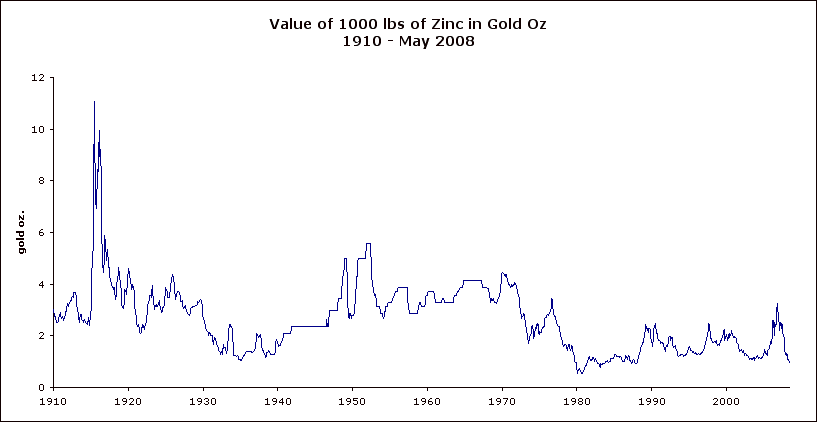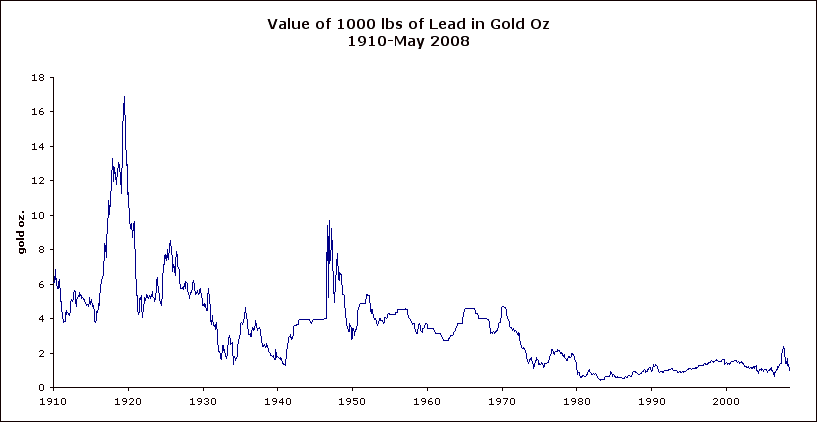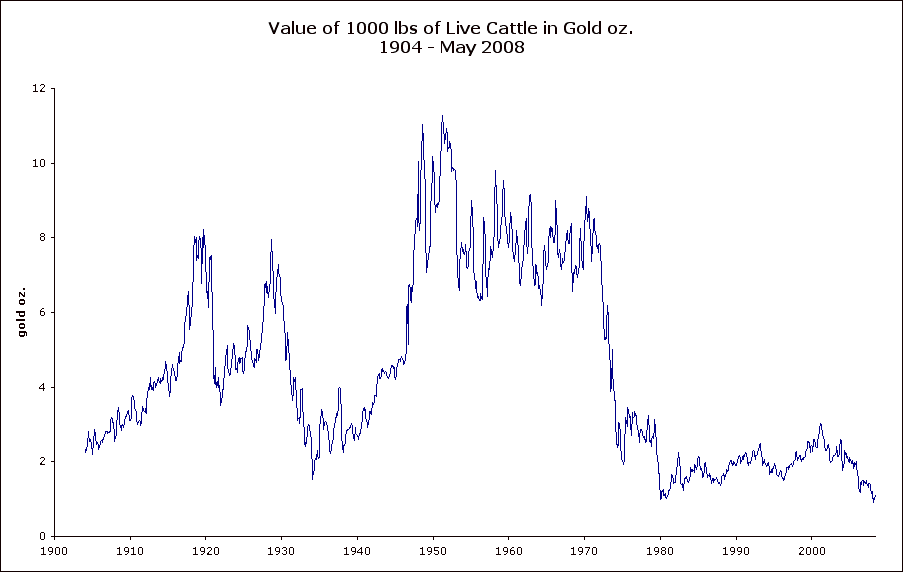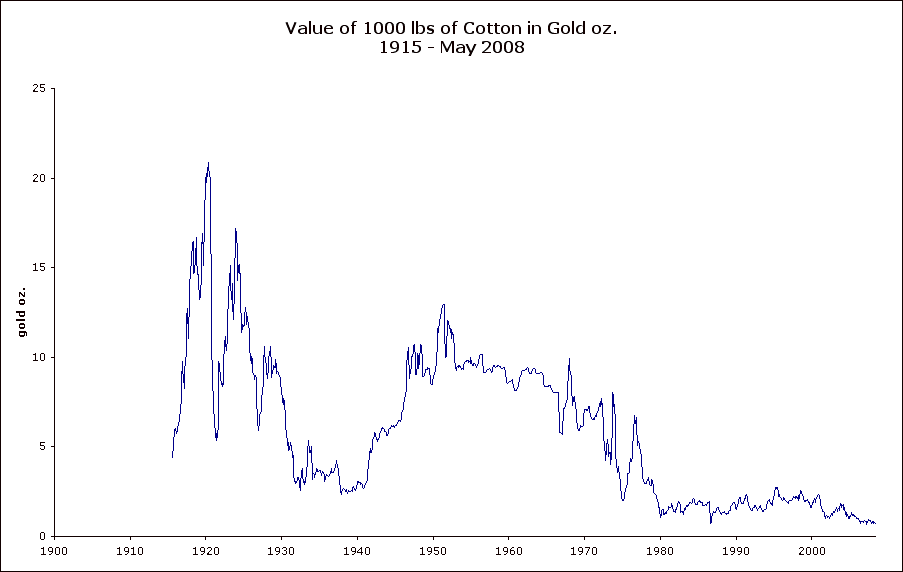More Commodities Charts
June 17, 2008
When the value of money changes, nominal prices become less and less meaningful. Often it is illuminating to measure prices in real money, which has always meant gold. When we do this, we see that commodity prices haven’t really risen that much. The rise in nominal prices can be mostly explained as a decline in dollar currency value. When the dollar falls in value, it takes more and more of them to buy things.
Here are a few more of our long-term charts, updated to May 2008.

Base metals have had a big retreat. Base metals are sensitive to capex in general, and a pullback in activity in China etc. could mean weakness here. However, there has already been a 60% decline to the lowest gold levels in twenty years. So, maybe the bad news is already in.

A similar story. For some reason, this looks like a chart that wants to go higher. The sudden breakout to new highs, followed by a harsh retreat, says “the game is different now.” But, that is just guessing really.

Meat producers are really getting crushed between higher grain (feed) prices and crappy selling prices. Here, we are just about touching all-time lows. I’ve heard that hog producers have literally been killing piglets and tossing them in a compost heap. They have negative value at these prices. Such situations can never last for long, as long as people want to eat meat.

When cotton is this low, everyone plants corn or soybeans instead. Touching all-time lows. U.S. cotton production fell 11% in 2007 compared to 2006, as farmers switched to other crops. For 2008, the USDA expects U.S. cotton production to fall to 14.5m bales, from 19.2m bales in 2007, a 25% decline. The U.S. is the world’s second-largest cotton producer, at 20% of world production, behind China at 24%. World cotton production is expected to fall 2.6% in 2008 from 2007, to 119m bales. Demand is estimated at 127m bales. World inventories are expected to drop 7.8m bales to 54m bales, the lowest in five years. (Isn’t that interesting?)
* * *
Now the Fed and ECB are mumbling about raising their policy rate targets. Will higher central bank target rates stop the inflation? I doubt it. Historically, when central bank target rates are below the official rate of inflation (CPI), currency weakness tends to result. The CPI is basically a lie at this point. If it was being maintained as it was before, it would probably be over 5% in the U.S. Maybe over 6%. In general, central bankers seem to like a policy rate of about 1.5% over the CPI, so even by their own standards they would have to be around 6.5% – 7.5% or so to be “neutral” or marginally “hawkish.” This is all delusion in any case, but I think it is significant that central bankers are easy-peasy even by their own standards. It shows the line of thinking. Over time, I’ve come to appreciate that this “line of thinking” is as important to currency values, in today’s chaotic floating-currency environment, as other, more concrete factors. If a central banker isn’t even trying to be “hawkish,” according to his own conception of “hawkishness” whether valid or not, then why should anyone expect a currency-positive result? I think this Taylor-rule-type “1.5% over the (unmodified) CPI” guideline is very common among the academic economists, so it can be used as a sort of litmus test for where a central banker imagines himself along the easy/hawkish spectrum.
I say it is delusion because rate targeting systems do not reliably affect the value of currencies. The rate-targeting policy is really a method of (attempted) economic management. It is not a method of currency value management, and is essentially unusable in this role. It’s like using a garden hose to hammer nails. In 1973, Arthur Burns went to 10%+, but it didn’t help stop the inflation (currency decline), which worsened into 1974. It did blow up the economy, however. Indeed, it is this blow-up-the-economy effect of higher rate targets that often leads to currency weakness in many cases. Just think what would happen to the dollar if the Fed went to 8% tomorrow. Up or down? Hard to say, but I would put the probabilities on down. The fact that Burns was “hawkish” (showing that he was prioritizing currency quality over unemployment etc.) was not sufficient, but I think it was essentially necessary. The dollar had a big rise beginning around the start of 1975, which I think had a lot to do with a trend toward significant tax cuts by both Republican and Democratic parties, but especially the Democrats. Within this context, Burns was able to cut his policy rates in 1975, and these rate cuts probably helped the dollar to rise further, as it took the burden of high interest rates off the economy.
Remember, higher Fed interest rate targets never stopped the 1970s inflation. It was only when the interest rate targeting system was abandoned, in October 1979, in favor of the Monetarist system, that the inflation was messily and painfully brought to an end. (The Monetarist system was like using a paint brush to hammer nails. Totally inappropriate, but if you tried hard enough you might manage to do it.) Much the same could be said of the various currency breakdowns in 1998. The successful Asian governments never got anywhere with the rate target hikes recommended by the IMF. Even when target rates were raised to absurd levels in excess of 30%, the currencies just fell further as the economy collapsed. It was only when they abandoned such techniques and adopted an ad-hoc Monetarist/direct base-money approach that currencies stabilized and actually rose dramatically. You could say something similar of Japan’s deflation in the 1990s. No amount of BOJ rate cuts solved the problem of the too-high (deflationary) yen. It was only when the rate-targeting process was abandoned in favor of “quantitative easing” that progress was made. This makes me think that the present inflationary trend also will not come to an end until the rate-targeting system is abandoned for another, more Monetarist-flavored method, or better yet a gold standard. Since this is politically way off in the distance, probably we have many more years of worsening inflation until that point.
Obama is pretty much a sure winner in the election this year. He actually has a tax cut program, mainly aimed at lower incomes, which I will have to look into further. However, this is matched with a reversal of the Bush tax cuts, on capgains, dividends and so forth. On balance, the Obama plan is probably a net economic and currency negative. In practice, I would not be surprised if his tax cut plans (raising the minimum taxable income to $50,000 for seniors for example) run into difficulties given declining government tax revenues in the midst of recession, and only the phase-out of the Bush tax cuts (i.e. a tax hike) is implemented.

